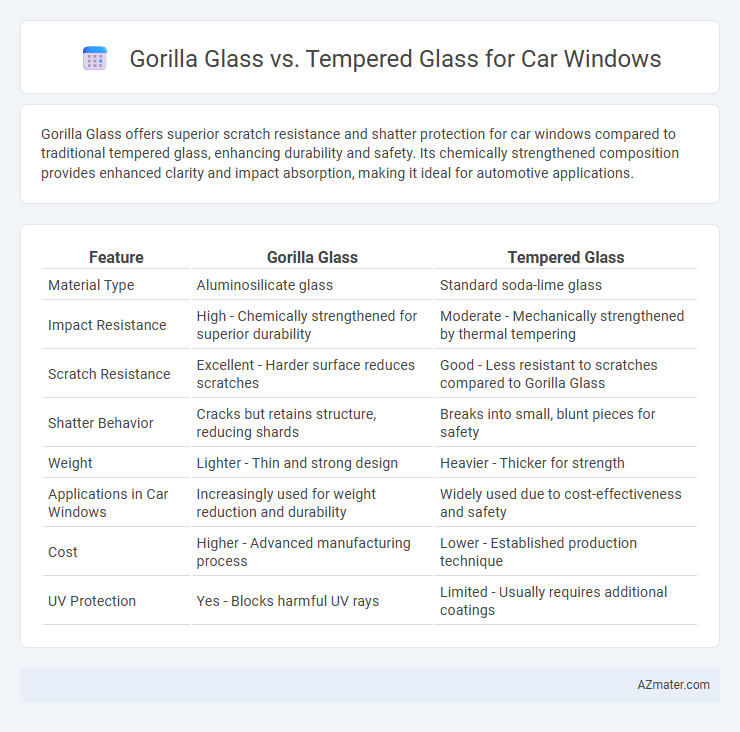Gorilla Glass offers superior scratch resistance and shatter protection for car windows compared to traditional tempered glass, enhancing durability and safety. Its chemically strengthened composition provides enhanced clarity and impact absorption, making it ideal for automotive applications.
Table of Comparison
| Feature | Gorilla Glass | Tempered Glass |
|---|---|---|
| Material Type | Aluminosilicate glass | Standard soda-lime glass |
| Impact Resistance | High - Chemically strengthened for superior durability | Moderate - Mechanically strengthened by thermal tempering |
| Scratch Resistance | Excellent - Harder surface reduces scratches | Good - Less resistant to scratches compared to Gorilla Glass |
| Shatter Behavior | Cracks but retains structure, reducing shards | Breaks into small, blunt pieces for safety |
| Weight | Lighter - Thin and strong design | Heavier - Thicker for strength |
| Applications in Car Windows | Increasingly used for weight reduction and durability | Widely used due to cost-effectiveness and safety |
| Cost | Higher - Advanced manufacturing process | Lower - Established production technique |
| UV Protection | Yes - Blocks harmful UV rays | Limited - Usually requires additional coatings |
Introduction: Gorilla Glass vs Tempered Glass for Car Windows
Gorilla Glass and tempered glass differ significantly in their composition and performance for car windows. Gorilla Glass, made from alkali-aluminosilicate, offers superior scratch resistance and is lighter than traditional tempered glass, enhancing fuel efficiency. Tempered glass, created through thermal or chemical strengthening, provides excellent impact resistance and safety by shattering into small, blunt pieces upon breakage, minimizing injury risks.
What is Gorilla Glass?
Gorilla Glass is a chemically strengthened, durable aluminosilicate glass designed to resist scratches and impacts, commonly used in smartphones and increasingly in automotive applications. Unlike traditional tempered glass, which relies on thermal treatment to enhance strength, Gorilla Glass undergoes an ion-exchange process that creates a compressive layer, improving both toughness and clarity. Its lightweight and high resistance to damage make Gorilla Glass an innovative choice for car windows, offering enhanced safety and visibility compared to conventional tempered glass.
What is Tempered Glass?
Tempered glass is a type of safety glass processed by controlled thermal or chemical treatments to increase its strength compared to normal glass. It is designed to shatter into small, blunt pieces upon impact, reducing the risk of injury in car windows. Commonly used in automotive side and rear windows, tempered glass offers durability and enhanced safety but lacks the scratch resistance and lightweight benefits of Gorilla Glass.
Strength and Durability Comparison
Gorilla Glass offers superior strength and scratch resistance compared to traditional tempered glass used in car windows due to its chemically strengthened composition and higher surface compression. Tempered glass, while robust against impact and thermal stress, tends to shatter into small pieces upon breaking, providing safety but less durability under continuous abrasion. The advanced aluminosilicate structure of Gorilla Glass enhances durability, making it more resistant to chips and cracks from road debris, extending the lifespan of car windows in demanding driving conditions.
Scratch Resistance: Which Glass Performs Better?
Gorilla Glass demonstrates superior scratch resistance compared to tempered glass due to its chemically strengthened surface, which effectively prevents minor abrasions commonly caused by debris or car washes. Tempered glass, while highly durable against impact, is more prone to surface scratches because its strength derives from internal tension rather than surface treatment. For enhanced scratch protection on car windows, Gorilla Glass offers a more resilient option that maintains clarity and aesthetics over time.
Safety and Shatter Resistance
Gorilla Glass offers superior shatter resistance and enhanced durability for car windows, reducing the risk of breaking into sharp shards during impact. Tempered glass, while strong and able to withstand significant force, generally breaks into small, blunt pieces to reduce injury but is more prone to cracking under stress. Safety-wise, Gorilla Glass provides a higher level of protection due to its advanced chemical strengthening and flexibility, making it increasingly preferred for automotive applications.
Weight and Thickness Differences
Gorilla Glass used in car windows is significantly thinner and lighter compared to traditional tempered glass, offering up to 30% weight reduction while maintaining high durability and strength. Tempered glass typically ranges from 4 to 6 mm in thickness, whereas Gorilla Glass can be manufactured around 1 to 2 mm, contributing to overall vehicle weight savings and improved fuel efficiency. The thinner profile of Gorilla Glass also supports enhanced design flexibility without compromising safety standards required for automotive windows.
Cost and Affordability
Gorilla Glass offers enhanced durability and scratch resistance but comes at a significantly higher cost compared to traditional tempered glass, impacting overall affordability for car windows. Tempered glass remains the more economical option, providing adequate strength and safety features while keeping replacement and repair expenses low. For budget-conscious consumers, tempered glass represents the most cost-effective solution without compromising essential protection.
Installation and Replacement Considerations
Gorilla Glass offers a thinner, lighter profile that can simplify installation in car windows, reducing the need for structural modifications, whereas tempered glass is thicker and heavier, often requiring specialized equipment for fitting. Replacement of Gorilla Glass may be less frequent due to its enhanced scratch resistance and durability, but when damaged, it typically demands manufacturer-specific handling and tools. Tempered glass is widely available and easier to replace using standard automotive repair methods, making it a cost-effective choice for conventional car window maintenance.
Which Glass is Best for Your Car Window?
Gorilla Glass offers superior scratch resistance and lighter weight compared to traditional tempered glass, making it ideal for enhancing visibility and vehicle fuel efficiency. Tempered glass excels in impact resistance and shatters into small, blunt pieces, maximizing passenger safety during accidents. Choosing Gorilla Glass or tempered glass for your car window depends on whether you prioritize durability and weight reduction or maximum safety and impact resistance.

Infographic: Gorilla glass vs Tempered glass for Car window
 azmater.com
azmater.com